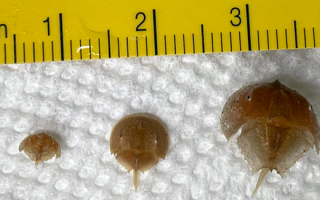Atlantic Horseshoe Crab

We call them crabs, but Atlantic horseshoe crabs (Limulus polyphemus) are more closely related to spiders and scorpions than true crabs. These “living fossils” have been on Earth for more than 445 million years—that’s older than the dinosaurs. Today, it is still almost identical to its ancient ancestors. Their bodies are composed of three parts: the prosoma (head / front shell), the opisthosoma (body / back shell), and the telson (tail). The name “horseshoe crab” comes from the prosoma, which resembles a horseshoe.
Limulus use their spikey tails to help right themselves if they are flipped over. They come ashore during the new and full moons in the spring to spawn and females can lay 100,000 eggs over the course of a few nights. These eggs are a critical food source for the red knot, a migratory bird with one of the longest known migration ranges—9,000 miles! Like their other arthropod cousins, horseshoe crabs molt their shells to grow. These molts, which look like hollow versions of a horseshoe crab, can often be seen on local beaches.
Type: Invertebrate
Habitat: Shallow, coastal waters on sandy or muddy bottoms
Range: Gulf and Atlantic Coasts of North America
Life Span in the Wild: 20 – 40 years
Size: up to 2 ft long (including tail)
Weight: 3 – 4 pounds
Diet: Carnivore: worms, bivalves, and other small bottom-dwelling organisms
Status: Vulnerable

Amazingly, horseshoe crabs have five sets of eyes, as well as the largest rods and cones (the cells responsible for vision) of any known animal. These are compound eyes that function similarly to human eyes. MBL researchers have been studying the eyes of horseshoe crabs for decades, revealing much of what we know about human vision. The 1967 Nobel Prize in Physiology was awarded to researchers who described inhibition—a big breakthrough in understanding how vision works. This work was done, in part, at the MBL.
Unlike humans, horseshoe crabs have blue blood. This is because of the protein hemocyanin which is copper-rich vs human’s red blood which has the iron-based hemoglobin protein. The blood of Limulus polyphemus is used in biomedical research to test pharmaceuticals and medical devices for potentially deadly endotoxins. This test, called Limulus Amebocyte Lysate (LAL), takes advantage of the horseshoe crab’s primitive immune system. Horseshoe crab blood contains amebocytes, which play a similar role to the white blood cells of vertebrates in defending the organism against pathogens. These amebocytes cause the horseshoe crab blood to clot when it encounters potentially harmful gram-negative bacteria. Each year, the medical industry catches around half a million horseshoe crabs just to harvest their blood—but a synthetic alternative is slowly replacing this practice.


